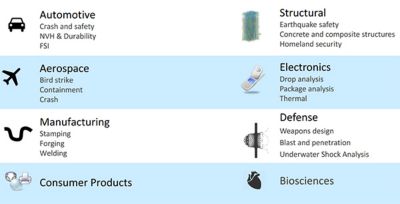-
-
학생용 무료 소프트웨어에 액세스하기
차세대 엔지니어에게 힘을 실어주는 Ansys
학생들은 세계적 수준의 시뮬레이션 소프트웨어를 무료로 이용할 수 있습니다.
-
지금 바로 Ansys에 연결하십시오!
미래를 설계하기
시뮬레이션이 다음 혁신을 어떻게 지원할 수 있는지 알아보려면 Ansys와 연결하십시오.
국가
무료 트라이얼
제품 및 서비스
학습하기
회사 정보
Back
제품 및 서비스
Ansys Blog
November 14, 2019
Simulate Crashes and Other Nonlinear Dynamics With Ansys
Engineers will experience a lot of benefits from the recent Ansys acquisition of Livermore Software Technology Corporation (LSTC). These benefits will center around the integration of linear and nonlinear simulation technologies.
For instance, engineers can use Ansys Mechanical to study linear deformations that happen over large time steps. LS-DYNA, on the other hand, can handle nonlinear deformations that happen in milliseconds. Combining these studies has various applications in the automotive, aerospace, manufacturing, electronics and defense industries.
The demand to use both technologies in a complementary capacity led to a partnerships, lasting decades, that saw the incorporation of Ansys LS-DYNA into the Ansys Workbench platform. With the acquisition, simulation users should expect to see this integration expand.
For instance, LS-DYNA users will experience increased access to, and compatibility with, the Ansys portfolio of pervasive engineering simulation technology. They will also have uninterrupted access to:
- LS-OPT — for design optimization and probability analysis
- LS-PrePost — for pre- and post-processing
- LS-TaSC — for topology and shape optimization
- LSTC Models – of crash test dummies, barriers and tires
Ansys users, meanwhile, will benefit from new capabilities in nonlinear dynamics, explicit time integration and multiphysics. They will be able to study events in which objects experience high loads over short periods of time.
What is Nonlinear Dynamics?
When engineers study linear dynamics, mechanical forces are typically determined by how much an object has deformed. In this case, Hooke’s law states that the force is equal to the deformation times a constant that is material dependent.
Hooke’s law doesn’t just model springs; it is the prototype for all linear mechanical simulation models.
This crash cannot be simulated using
linear equations, because the deformations
remain after the force has reduced to
zero. Therefore, it is a nonlinear system
However, an assumption in Hooke’s law — that everything returns to its original shape — means that it is unable to model every structural situation. For instance, it cannot model plastic deformations — as anybody who has stretched a spring too far knows.
Nonlinear dynamics is the study of systems that operate in a manner that can’t be simplified into a linear equation. Examples include rubber (which experiences nonlinear elasticity) and crash simulations (where damage remains after forces on the object are removed).
Nonlinear dynamics is calculated using explicit time steps. With explicit time, the forces are determined at each time step based on the previous state of the system. These forces are then used to determine the next iteration of the system.
How to Simulate Nonlinear Dynamics
LS-DYNA specializes in nonlinear dynamics like impact, metal stamping, jet-engine bird strike, earthquake, explosion and crash simulations. These kinds of simulations are employed in the design of cars, aircraft, spacecraft, manufacturing lines, electronics and defense equipment.
Using LS-DYNA, simulation engineers can assess various
nonlinear dynamic problems like the landing of the Orion spacecraft
LS-DYNA is also able to study multiphysics, multiscale, multistage simulations with wide scalability. This means that engineers can solve small problems (using a desktop’s processors) or large complex problems (using thousands of processors on a cluster).
As for LS-DYNA’s ability to model various physics, its capabilities include (but are not limited to):
- Computational fluid dynamics (CFD)
- Granular flow
- Electromagnetism
- Fluid-structure interactions
- Noise, vibration and harshness (NVH)
- Thermal transfer
- Crack formation and failure
- Composites
LS-DYNA has many features, so choosing the right parameters to set up a simulation can be complex. Workbench automates this process so users can benefit from the robust capabilities of LS-DYNA without having to worry about the details. This access enables engineers to become productive with nonlinear dynamic simulation with minimal training.
Crash Simulation Ubiquity Can Expand Other Modeling Technologies
LS-DYNA’s ability to simulate car crashes can reduce the number of physical prototypes needed during development. As a result, most automotive organizations use these simulations to design and optimize automotive components and vehicles.
Combining LS-DYNA with the Ansys portfolio opens up new applications within the automotive industry.
Automotive engineers can use
LS-Dyna to create crash simulations
to reduce the number of physical tests
that are needed to certify the car
For instance, Ansys has shown great commitment to the automotive market with autonomous vehicle, electrification, aerodynamics, NVH, embedded software and other technologies.
Adding automotive crash simulations to this lineup will entice users to gravitate to adjacent simulation technologies, so they can completely optimize their products within one software portfolio.


